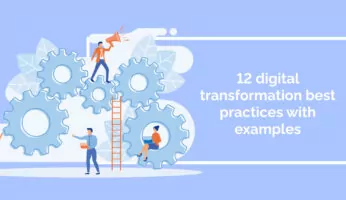
Countless words have been written about digital transformation across every industry, including HR — but what does this mean in the real world when it comes to workforce planning? What digital tools are being used by HR professionals to make their working lives easier? And how are these tools boosting businesses? When it comes to making the investment in digital tools for workforce planning, it is important to be able to demonstrate the financial benefits to senior management.
Navigating the digital tools marketplace
Deciding what digital tools will be right for your business needs, including workforce planning, can be overwhelming. There are many digital tools which have been used successfully by many businesses for day-to-day HR functions — this can be a good place to start the digital transformation journey.
For example, PromoVeritas, a UK promotional compliance company, has introduced Citation, a people management tool that has digitized processes such as holiday requests, logs for sick leave, updating staff contact details and enabling annual training programs for health, safety and data protection. This has streamlined processes, integrated the HR function across managers rather than having one HR manager, and saved money.
Once a company starts using digital tools to make functions such as time tracking, task management and payroll easier, a culture of digitization is created.
When taking digitization to the next level by applying it to workforce planning projects, Victoria Bond from Space HR has a great tip to get the ball rolling. She suggests investing in a digital employee feedback tool to engage the whole business in decision-making. This is an easy way to start the process of strategic workforce planning and optimization, which involves the whole organization rather than just the HR department.
Bond says these platforms “typically use anonymous feedback surveys to understand how it feels to work in a business”. This is then used to measure the effectiveness of business decisions and change, and understand how this affects employees. Regularly collecting and using employee-generated data helps organizations understand what is holding teams back, what drives them forward and can flag up indicators for staff turnover.
Once an organization has dipped a toe in the digital waters, introducing new tools becomes less intimidating and employees across all teams can be engaged in workforce planning and optimization processes. Advancing to tools that incorporate artificial intelligence for functions such as data collection and analysis becomes a logical next step for organizational improvement and positive change rather than being viewed as an extravagance.
Digital tools are essential for any organization that is serious about taking a data-driven approach to workforce planning. For example, investing in technology that tracks employee training is an effective way to gather data on a wide range of metrics, including training completion rates, productivity increases after training, and areas for improvement. This information is invaluable for helping organizations identify training needs and plan future training.
Using software to gather data in real-time, such as performance and productivity metrics, allows managers to detect problems as they start to emerge rather than discovering issues only once they have become more serious and potentially costly. This is a clear example of how businesses can benefit from digitization as part of a process of workforce planning and the accompanying change management.
How do digital tools boost businesses?
Presenting a business case for investing in workforce planning technology can be challenging, but it is definitely an easier proposition when senior managers can see demonstrable bottom line benefits. The return on investment (ROI) for HR technology is an important factor for decision-makers when looking at budgets.
Bottom line benefits to investing in the right digital tools for HR include:
- Improved productivity: When investing in digital systems that save time, especially if formerly manual administration tasks can be automated, employees can focus on tasks that directly help build the business.
- Early troubleshooting: If technology can be used to pinpoint problems, such as excessive or unexplained staff absences, early action can be taken before the issues become expensive.
- Market intelligence: Data-driven tools can be used to collect and analyze market data as well as employee information for more accurate business forecasting.
- Localizing workforce planning: Big companies and government organizations, such as public healthcare services, in particular can benefit from digital solutions that mean tailored, region-specific workforce planning can take place at a local level rather than remotely.
- Better hiring decisions: Using software to help assess job applications saves time in the recruiting process and helps prevent costly mistakes related to hiring the wrong people.
- Combating skills shortages: Digital tools can enable organizations to develop searchable talent banks and reduce the risk of a costly skills shortage, whether it is caused by internal or external change.
In regard to optimizing recruitment, one of the biggest time and cost pressures of the hiring process is the hours, days and sometimes even weeks spent reviewing job applications. But investment in the right digital tools streamlines this process and helps with planning when employers can easily identify talent for active or future job opportunities.
Paul Hayler, resourcing manager at London & Southeastern Railway, uses Tribepad software to categorize and automatically communicate with candidates, and retain easily accessible talent when other roles open up. The company regularly receives more than 1,000 applications each month, which means the recruitment process can be time-consuming. However, using a software solution that allows candidates to log on themselves and check the process of their applications is a great time-saver. For candidates who might not have been suitable for an opportunity, but could potentially fill future roles, the software allows the railway company to create a digital talent bank, which facilitates recruitment in the longer term.
Engaging employees across the entire organization is an important part of strategic workforce planning and ongoing workforce optimization. Hayler reports that the software has the additional advantage of being able to automatically update employees and potential employees on company news and upcoming job vacancies.
Citing real world examples of how investment in digital technology saves time and money while improving organizational engagement and communication is a powerful way for HR professionals to bolster the business case for new solutions.
WalkMe Team
WalkMe spearheaded the Digital Adoption Platform (DAP) for associations to use the maximum capacity of their advanced resources. Utilizing man-made consciousness, AI, and context-oriented direction, WalkMe adds a powerful UI layer to raise the computerized proficiency, everything being equal.



